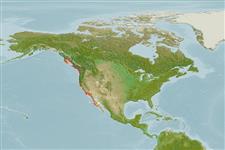Environment: milieu / climate zone / depth range / distribution range
Ökologie
seewasser; brackwasser demersal; tiefenbereich 0 - 2 m (Ref. 96339). Subtropical; 55°N - 22°N, 136°W - 111°W
Eastern Pacific: Rivers Inlet, British Columbia, Canada to Baja California, Mexico.
Size / Gewicht / Alter
Maturity: Lm ? range ? - 3.4 cm
Max length : 6.4 cm SL Männchen/unbestimmt; (Ref. 27436); common length : 4.2 cm TL Männchen/unbestimmt; (Ref. 12193); max. veröff. Alter: 3.00 Jahre (Ref. 72494)
Rückenflossenstacheln (insgesamt) : 4 - 5; Rückenflossenweichstrahlen (insgesamt) : 15 - 17; Afterflossenstacheln: 0; Afterflossenweichstrahlen: 14 - 17. Caudal rounded.
Inhabits sand or mud bottom. Retreats into shrimp burrows when threatened and at low tide (Ref. 6885). Commonly in estuaries, lagoons and tidal sloughs. Reported to occur in freshwater. Adults feeds on diatoms, green algae, tintinnids, eggs and young of their hosts (Ref. 6885). Positions large food particles near crabs to be torn to smaller pieces (Ref. 6885). Preyed upon by Sebastes, staghorn sculpin, whitespot greenling, and terns (Ref. 6885). Unlike other gobies, it does not build a nest or care for its young (Ref. 2850).
Eschmeyer, W.N., E.S. Herald and H. Hammann, 1983. A field guide to Pacific coast fishes of North America. Boston (MA, USA): Houghton Mifflin Company. xii+336 p. (Ref. 2850)
IUCN Rote Liste Status (Ref. 130435)
Bedrohung für Menschen
Harmless
Nutzung durch Menschen
Fischereien: kommerziell; Aquarium: Öffentliche Aquarien
Tools
Zusatzinformationen
Download XML
Internet Quellen
Estimates based on models
Preferred temperature (Ref.
123201): 9.4 - 18.5, mean 10.8 °C (based on 189 cells).
Phylogenetic diversity index (Ref.
82804): PD
50 = 1.0000 [Uniqueness, from 0.5 = low to 2.0 = high].
Bayesian length-weight: a=0.00977 (0.00442 - 0.02163), b=3.05 (2.86 - 3.24), in cm total length, based on LWR estimates for this (Sub)family-body shape (Ref.
93245).
Trophic level (Ref.
69278): 3.1 ±0.42 se; based on food items.
Widerstandsfähigkeit (Ref.
120179): hoch, Verdopplung der Population dauert weniger als 15 Monate. (tm=1; tmax=2.5).
Fishing Vulnerability (Ref.
59153): Low vulnerability (10 of 100).
